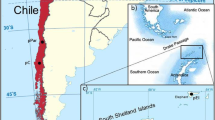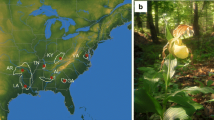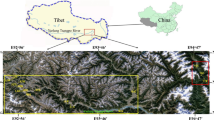Abstract
In this work we assessed the genetic diversity of 32 C. calceolus populations from Poland. Mean genetic diversity was moderate (P = 36.4%, A = 1.58, H O = 0.143, F IS = 0.059), and seven geographic regions did not differ significantly in their levels of polymorphism (p > 0.05), although allele frequencies varied greatly. Only four unique alleles were found, at three sites in southern and southeastern Poland. Genetic (P, A) and genotypic diversity parameters (G, G U) were significantly correlated with population size (p < 0.001). In the 32 studied populations we separated 422 different multilocus genotypes; none was common to all populations. Overall population differentiation was moderate at 0.137 (p < 0.001), but we found a significant pattern of isolation by distance for the whole dataset (r 2 = 0.65, p < 0.001). Our chloroplast DNA (cpDNA) results suggest a single evolutionary lineage and a common origin for all Polish C. calceolus populations. Information about the genetic health of C. calceolus populations should be useful in developing conservation strategies.




Similar content being viewed by others
References
Aagaard JE, Harrod RJ, Shea KL (1999) Genetic variation among populations of rare clustered lady-slipper orchid (Cypripedium fasciculatum) from Washington State. USA Natl Areas J 19:234–238
Ackerman JD (1998) Evolutionary potential in orchids: patterns and strategies for conservation. Selbyana 19:8–14
Alexandersson R, Ågren J (2000) Genetic structure in the nonrewarding, bumblebee-pollinated orchid Calypso bulbosa. Heredity 85:401–409
Allen GA, Antos JA, Worley AC, Suttill TA, Hebda RJ (1996) Morphological and genetic variation in disjunct populations of the avalanche lily Erythronium montanum. Can J Bot 74:403–412
Avise JC (1994) Molecular markers, natural history and evolution. Chapman and Hall, New York
Bänziger H, Sun H, Luo Y (2008) Pollination of wild lady slipper orchid Cypripedium yunnanense and C. flavum (Orchidaceae) in south-west China: why are there no hybrids? Bot J Linn Soc 156:51–64
Barrett SCH, Kohn J (1991) Genetic and evolutionary consequences of small population size in plant: implications for conservation. In: Falk DA, Holsinger KH (eds) Genetics and conservation of rare plants. Oxford University Press, Oxford, pp 3–30
Bornbusch AH, Swender LA, Hoogerwerf DL (1994) Genetic variation in Massachusetts populations of Cypripedium arietinum R. Brown in Ait. and C. acaule Ait. (Orchidaceae). Rhodora 888:354–369
Borowski S (1963) Obuwik w Białowieskim Parku Narodowym. Chrońmy Przyr Ojcz 19(6):45–47
Broyles SB (1998) Postglacial migration and the loss of allozyme variation in northern populations of Asclepias exaltata (Asclepiadaceae). Am J Bot 85:1091–1097
Brzosko E (2002) Dynamics of island populations of Cypripedium calceolus in the Biebrza river valley (NE Poland). Bot J Linn Soc 139:67–77
Brzosko E, Werpachowski C (1998) Island population of Cypripedium calceolus. In: Falińska K (ed) Plant population biology and vegetation processes. Kraków: W. Szafera Institute of Botany. Polish Academy of Science, pp 111–113
Brzosko E, Wróblewska A (2003) Genetic variation and clonal diversity in island Cephalanthera rubra populations from the Biebrza National Park. Bot J Linn Soc 143:99–108
Brzosko E, Ratkiewicz M, Wróblewska A (2002a) Allozyme differentiation and genetic structure of Lady’s slipper island populations (Cypripedium calceolus) in NE Poland. Bot J Linn Soc 138:433–440
Brzosko E, Wróblewska A, Ratkiewicz M (2002b) Spatial genetic structure and clonal diversity of island populations of Lady’s slipper (Cypripedium calceolus) from the Biebrza National Park (northeast Poland). Mol Ecol 11:2499–2509
Brzosko E, Wróblewska A, Ratkiewicz M, Till-Bottraud I, Nicolè F, Baranowska U (2009) Resources of Cypripedium calceolus genetic diversity at the edge and in the centre of European geographical range. Ann Bot Fennici 46:201–214
Case MA (1993) High levels of allozyme variation within Cypripedium calceolus (Orchidaceae) and low levels of divergence among its varieties. Syst Bot 18(4):663–677
Case MA (1994) Extensive variation in the levels of genetic diversity and degree of relatedness among five species of Cypripedium (Orchidaceae). Am J Bot 81(2):175–184
Case MA, Mlodozeniec HT, Wallace LE, Weldy TW (1998) Conservation genetics and taxonomic status of rare Kentucky lady’s slipper: Cypripedium kentuckense (Orchidaceae). Am J Bot 85(12):1779–1786
Chung MG (1995) Low levels of genetic diversity within populations of Hosta clausa (Liliaceae). Pl Spec Biol 9:177–182
Cozzolino S, Noce ME, Musacchio A, Widmer A (2003) Variation at a chloroplast minisatellite locus reveals the signature of habitat fragmentation and genetic bottleneck in the rare orchid Anacamptis palustris (Orchidaceae). Am J Bot 90:1681–1687
Cribb P (1997) The Genus Cypripedium. Timber, Portland
Cribb P, Sandison MS (1998) A preliminary assessment of the conservation status of Cypripedium species in the wild. In: Waite S (ed) Orchid population biology: conservation and challenges. Bot J Linn Soc 126:183–190
Després L, Loriot S, Gaudeul M (2002) Geographic pattern of genetic variation in the European globeflower Trollius europaeus L. (Ranunculaceae) inferred from amplified fragment length polymorphism markers. Mol Ecol 11:2337–2347
Ellstrand NG, Ellam DR (1993) Population genetic consequences of small population size: implications for plant conservation. Annu Rev Ecol Syst 24:217–242
Ellstrand NC, Roose ML (1987) Patterns of genotypic diversity in clonal plant species. Am J Bot 74:123–131
Frankel OH, Brown AHD, Burdon JJ (1995) The Conservation of Plant Biodiversity. Cambridge University Press, Cambridge
Frankham R (1995) Conservation genetics. Annu Rev Genet 29:305–327
Frankham R, Ballou JD, Briscoe DA (2003) Introduction to conservation genetic. Cambridge University Press, Cambridge
Gitzendanner MA, Soltis S (2000) Patterns of genetic variation in rare and widespread plant congeners. Am J Bot 87:783–792
Golden Software, 2002. Contouring and 3D surface mapping for scientist and engineers. Golden Software, Inc., Golden, CO
Goudet J (2001) FSTAT, a program to estimate and test gene diversities and fixation indices (Version 2.9.3). Available from http://www.unil.ch/izea/softwares/fstat.html
Hall TA (1999) BioEdit: a user-friendly biological sequence alignment editor and analysis program for Windows 95/98/NT. Nucleic Acids Symposium Ser 41:95–98
Hamrick JL, Godt MJW (1989) Allozyme diversity in plant species. In: Brown AHD, Clegg MT, Kehler AC, Weir BS (eds) Plant population genetics, breeding, and genetic resources. Sinauer, Sunderland, Massachusetts
Hamrick JL, Godt MJW (1997) Effects of life history traits on genetic diversity in plant species. In: Silvertown J, Franco M, Harper JL (eds) Plant life histories-ecology, phylogeny, evolution. Cambridge University Press, Cambridge, pp 102–118
Honnay O, Jacquemyn H (2008) A meta-analysis of the relation between mating system, growth form and genotypic diversity in clonal plant species. Evol Ecol 22:299–312
Izawa T, Kawahara T, Takahashi H (2007) Genetic diversity of an endangered plant, Cypripedium macranthos var. rebunense (Orchidaceae): background genetic research for future conservation. Conserv Genet 8:1369–1376
Journel A, Huijbregts C (1978) Mining Geostatistics. Academic, London
Kang M, Jiang M, Huang H (2005) Genetic diversity in fragmented populations of Berchemiella wilsonii var. pubipetiolata (Rhamnaceae). Ann Bot London 95:1145–1151
Karron JD (1987) The pollination ecology of co-occurring geographically restricted and widespread species of Astragalus (Fabaceae). Biol Conserv 39:179–193
Karron JD (1991) Patterns of genetic variation and breeding systems in rare plant species. In: Donald AF, Holsinger KE (eds) Genetics and conservation of rare plants. New York, Oxford University Press, pp 87–98
Kaźmierczakowa R, Zarzycki K (2001) Polska Czerwona Księga Roślin. PAN, Kraków
Kennedy AH, Walker GL (2007) The population genetic structure of the showy lady’s-slipper orchid (Cypripedium Reginae Walter) in its glaciated and unglaciated ranges. Castanea 72:248–261
Klier K, Loeschke MJ, Wendel JF (1991) Hybridization and introgression in white and yellow lady slipper orchids Cypripedium-candidum and Cypripedium-pubescens. J Hered 82:305–318
Kull T (1999) Biological flora of the British Isles. Cypripedium calceolus L. J Ecol 87:913–924
Loveless MD, Hamrick JL (1984) Ecological determinants of genetic structure in plant populations. Annu Rev Ecol Syst 5:65–95
Łucka M (1950) Rośliny dziko rosnące sprzedawane na targach w Krakowie. Acta Soc Bot Pol 20:621–633
Mangerud J, Andersen ST, Berglund BE, Donner JJ (1974) Quaternary stratigraphy of Norden, a proposal for terminology and classification. Boreas 3:109–128
Marks L (2005) Pleistocene glacial limits in the territory of Poland. Przegląd Geologiczny 53:988–993
Michalik S, Michalik R (2000) Dynamika populacji i aktywna ochrona obuwika pospolitego Cypripedium calceolus L. w rezerwacie przyrody Michałowiec. Chrońmy Przyr Ojcz 6:13–28
Miller MP (1997) Tools for population genetic analyses (TFPGA) 1.3: a Windows program for the analysis of allozyme and molecular population genetic data. Computer Software distributed by author
Nicolè F, Brzosko E, Till-Bottraud I (2005) Population viability analysis of Cypripedium calceolus in a protected area: longevity, stability and persistence. J Ecol 93:716–726
Nilsson LA (1979) Anthecological studies on the Lady’s Slipper, Cypripedium calceolus (Orchidaceae). Bot Not 132:329–347
Piękoś-Mirkowa H, Mirek Z (2003) Flora Polski. Atlas roślin chronionych. Multico, Warszawa Pluess AR
Pluess AR, Stocklin J (2004) Population genetic diversity of the clonal plant Geum reptans (Rosaceae) in the Swiss Alps. Am J Bot 91:2013–2021
Pornon A, Escaravage N, Thomas P, Taberlet P (2000) Dynamics of genotypic structure in clonal Rhododendron ferrugineum (Ericaceae) populations. Mol Ecol 9:1099–1111
Premoli AC, Kitzberger T, Veblen TT (2000) Isozyme variation and recent biogeographical history of the long-lived conifer Fitzroya cupressoides. J Biogeogr 27:251–260
Rasmussen KK, Kollmann J (2008) Low genetic diversity in small peripheral populations of rare European tree (Sorbus torminalis) dominated by clonal reproduction. Conserv Genet 9:1533–1539
Raymond ML, Rousset F (1995) GENEPOP (Version 1.2): population genetics software for exact tests and ecumenism. J Hered 86:248–249
Reinhammar LG (1999) Allozyme differentiation between the lowland Carex capitata and the alpine Carex arctogena (Cyperaceae) in Scandinavia. Bot J Linn Soc 67:377–389
Richardson BJ, Adams M, Baverstock PR (1986) Allozyme electrophoresis. Academic, UK
Scacchi R, De Angelis G, Corbo RM (1991) Effect of breeding system in the genetic structure in three Cephalanthera spp. (Orchidaceae). Plant Syst Evol 176:53–61
Schneider S, Roessli D, Excoffier L (2000) Arlequin Version 2000: a software for population genetic data analysis Genetics and Biometry Laboratory. University of Geneva, Switzerland
Shefferson RP, Weiss M, Kull T, Taylor DL (2005) High specificity generally characterizes mycorrhizal association in rare lady’s slipper orchids, genus Cypripedium calceolus. Mol Ecol 14:613–626
Slatkin M (1985) Gene flow in natural populations. Annu Rev Ecol Syst 16:393–430
Soltis DE, Soltis PS (1989) Isozymes in plant biology. Dioscorides, Portland
StatSoft, Inc. (1995) Statistica for Windows. Computer program manual. Tulusa
Świeboda M (1976) Rozmieszczenie obuwika pospolitego Cypripedium calceolus L. w Polsce. Ochrona Przyrody 41:205–230
Sydes MA, Peakall R (1998) Extensive clonality in the endangered shrub Haloragodendron lucasii (Haloragaceae) revealed by allozymes and RAPDs. Mol Ecol 7:87–93
Taberlet P, Gielly L, Pautou G, Bouvet J (1991) Universal primers for the amplification of three non-coding regions of the chloroplast DNA. Plant Mol Biol 17:1105–1109
Takeshi I, Kawahara T, Takahashi H (2007) Genetic diversity of an endangered plant, Cypripedium macranthos var. rebunense (Orchidaceae): background genetic research for future conservation. Conserv Genet 6:1369–1376
Taniguchi H, Nakamura T, Mizukami H, Kawano S, Sano H, Katsumi M (2001) Identity of Cypripedium calceolus (Orchidaceae) in Rebun Island: Comparative DNA analysis of related species. Genes Genet Syst 76:181–188
Terschuren J (1999) Action plan for Cypripedium calceolus in Europe. Nat Environ 100:5–56
Torbjörn T (2002) Geographical distribution of allozyme variation in relation to post-glacial history in Carex digitata, a widespread European woodland sedge. J Biogeogr 29:919–930
Wallace LE, Case MA (2000) Contrasting allozyme diversity between northern and southern populations of Cypripedium parviflorum (Orchidaceae): implications for Pleistocene refugia and taxonomic boundaries. Syst Bot 25:281–296
Weir BS, Cockerham CC (1984) Estimating F-statistics for the analysis of population structure. Evolution 38:1358–1370
White TJ, Bruns T, Lee S, Taylor JW (1990) Amplification and direct sequencing of fungal ribosomal RNA genes for phylogenetics. In: Innis MA, Gelfand DH, Sninsky JJ, White TJ (eds) PCR protocols, a guide to methods and applications. Academic Press, San Diego
Widén B, Cronberg N, Widén M (1994) Genotypic diversity, molecular markers and spatial distribution of genets in clonal plants. In: Soukupová L, Marshall C, Hara T, Herben T (eds) Plant clonality: biology and diversity. Opulus Press, Uppsala, pp 139–157
Wika S, Bernacki L (1984) W obronie obuwika pospolitego Cypripedium calceolus w rezerwacie florystycznym Michałowiec. Chrońmy Przyr Ojcz 4:75–82
Wojterski T, Wojterska H (1953) Roślinność Dziewiczej Góry pod Poznaniem. Prace Komitetu Biologii PTPN 14(4):1–126
Wong KC, Sun M (1999) Reproductive biology and conservation genetics of Goodyera procera (Orchidaceae). Am J Bot 86:1406–1413
Young A, Boyle T, Brown T (1996) The population genetic consequences of habitat fragmentation for plants. Trends Ecol Evol 11:413–418
Zarzycki K, Szeląg Z (2006) Red list of the vascular plants in Poland. W. Szafer Institute of Botany, Polish Academy of Science, Kraków
Acknowledgments
We thank Adam Chlebowski, Marek Cieślak, Paweł Frąckowiak, Adam Hermaniuk, Adam Kawiński, Róża Kaźmierczakowa, Ewa and Maciej Korczyńscy, Marek Kucharczyk, Jacek Łoziński, Julita Minasiewicz, Zbigniew Mirek, Józek Mitka, Andrzej Szlachetka, Marek Śleszyński, Iwona Wróbel, Zdzisław Zaborowski and Joanna Znaniecka for their help collecting material in the field. Michael Jacobs edited the manuscript. The study was done within project 2P04C 048 30 financed by the Polish Ministry of Science and Higher Education.
Author information
Authors and Affiliations
Corresponding author
Appendix 1
Rights and permissions
About this article
Cite this article
Brzosko, E., Wróblewska, A., Tałałaj, I. et al. Genetic diversity of Cypripedium calceolus in Poland. Plant Syst Evol 295, 83–96 (2011). https://doi.org/10.1007/s00606-011-0464-9
Received:
Accepted:
Published:
Issue Date:
DOI: https://doi.org/10.1007/s00606-011-0464-9




